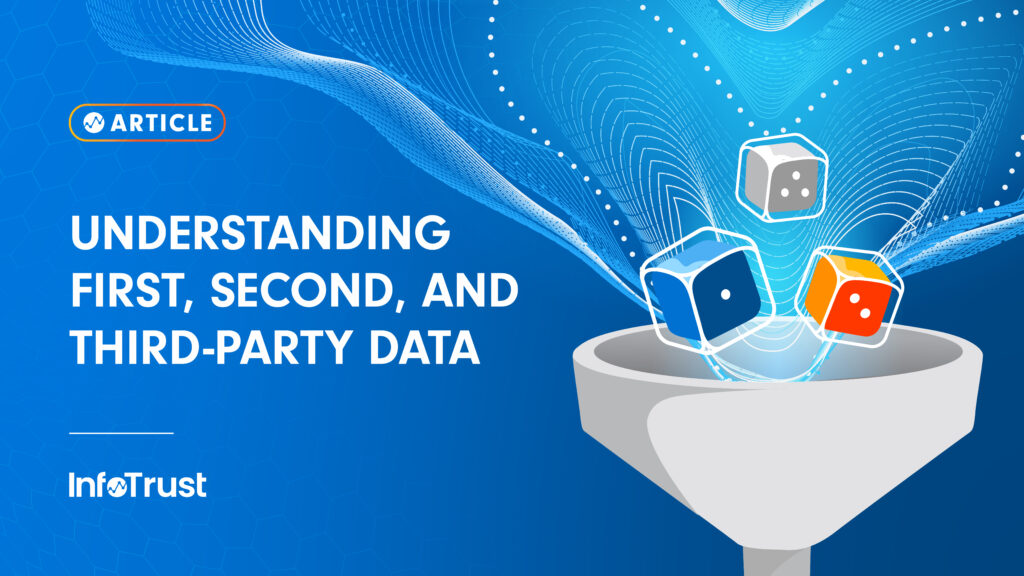You’re likely already seeing first-party and third-party terminology everywhere you look if you work in analytics, marketing, and all-things digital. But have you heard of second-party data? And even further, how about the burgeoning zero-party data?
While there’s no balloons or cake at this party, this article will be our gift to you for a greater understanding of what sets these different types of data apart, and how they can bring value to your organization.
First vs. Second vs. Third-Party Data Explained
First-Party Data
Think of first-party data as your most valuable data asset. This is information collected by your business and owned by your business, which is picked up through direct interactions with customers or users. Being that first-party data is as close to the source as you can get, it’s also going to often be the most durable, trustworthy, and privacy-centric data you have as an organization about your current and prospective customers.
Some examples of first-party data include account information (name, email, address), purchase history (items ordered, payment preferences, subscriptions owned), and digital analytics data such as that you are collecting in Google Analytics (common activities completed on the site, device types, content viewed).
In a world where data privacy is constantly evolving, thinking of strategies for how to leverage your owned, first-party data is key. This could include building audiences from your first-party data—something as simple as activating audiences from Google Analytics 4 directly to the ad platforms or advanced as applying machine learning on your marketing data warehouse to build out bidding strategies for various high-value activities. First-party data can also be used for better personalization on websites and apps, or through other marketing tactics like email, SMS, and push notifications. If you realize as you are reading this that you don’t have a significant amount of first-party data, this is also your opportunity to bring this to your organization as a key activity to focus on in 2024 and beyond as the reliance on owned and consented data is increasing.
Zero-Party Data
Haven’t heard of this one yet? Zero-party data started gaining significant traction as a concept only more recently as the reliance on owned data has grown. Think of zero-party data as a type of first-party data, so it’s still data that is collected and owned by your organization. However, the differentiator is that customers and users voluntarily and proactively offer zero-party data and are often focused on their preferences, interests, and intentions.
This type of data can often provide additional context or insights to previously collected first-party data, and one of the greatest benefits is that it’s also the most privacy-centric type of data because the customer or user willingly offers it.
Some examples of zero-party data would be a product recommendation quiz; think on a beauty site, you might see a “Find My Skincare Routine”. Information shared freely by the user such as skin type (dry, oily, combination, etc.), skincare concerns (dullness, uneven color, etc.) and product preferences (gel, cream, oil, etc.), would be considered zero-party data. Additionally, common zero-party data examples are found in account profile information such as birthday, favorite retail location, and survey responses such as favorite brand incentives.
Second-Party Data
The easiest explanation for second-party data is that it is another company’s first-party data. To use it successfully, it’s of utmost importance that the source of this data is trustworthy and reputable, and that the data is approved for use by the provider.
Often, second-party data is used to either expand the insights a company has about its customers or users by gaining access to datasets of information they could not otherwise collect on their own. Additionally, for companies who lack data about their audiences (or might be just starting up), it can be effective to get a sense of their audience or market opportunities more quickly than if they collected the data themselves.
Some tangible examples of second-party data are datasets shared by a publisher about its audiences to an advertiser, a credit card company sharing information with a hotel or airline partner, or an automotive manufacturer obtaining information from dealerships about the vehicles they are selling most and to whom.
Third-Party Data
The final type of data is third-party data, which is that collected by an external group that has no direct affiliation with the business. By nature of how the data is collected and aggregated, it can be challenging to ensure this data is truly relevant to the company accessing it. One other consideration is that often, third-party data can’t be easily integrated with other types of data (especially first and zero-party data) because it’s aggregated in nature and not often includes detailed or individualized records.
We regularly see third-party data in the form of market research reports about market/industry trends, consumer behavior, and demographics. More specific examples, however, could include datasets used for fraud detection, location data provided for ad targeting, and aggregate customer reviews and ratings to provide deeper insight into overall satisfaction.
What Type of Data Should My Business Use?
In a world where customers increasingly expect highly personalized experiences without sacrificing their privacy, the optimal approach is likely to encompass all data types. Relying solely on one type would inevitably result in gaps in understanding. For instance, focusing solely on zero and first-party data might lead to overlooking broader industry trends. Conversely, relying solely on second or third-party data might provide generic insights rather than the nuanced understanding needed for genuine and personalized customer experiences.
Ultimately, as you leverage data to inform strategies for reaching, engaging, and retaining customers, prioritize the fundamental value of respecting user privacy and ensuring compliant usage. Upholding these principles not only fosters trust with your brand, but also builds a sustainable foundation for long-term success in an increasingly data-driven landscape.


